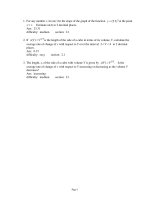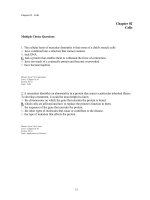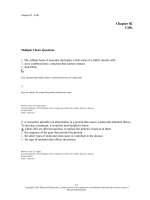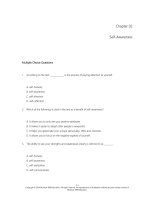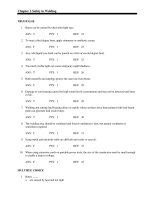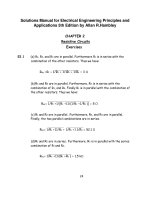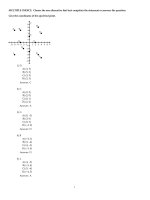Managerial communication strategies and applications 6th edition by hynes test bank
Bạn đang xem bản rút gọn của tài liệu. Xem và tải ngay bản đầy đủ của tài liệu tại đây (145.44 KB, 7 trang )
Managerial Communication: Strategies and Applications 6th edition by
Geraldine E. Hynes Test Bank
Link full download: />
1.
A listener’s experiences and different understanding of the meanings of words can
complicate and confuse the manager’s message.
*a. true
b. false
2.
Intercultural communication is more important in modern society than intrapersonal
communication.
a. true
*b. false
3. There is a positive correlation between communication openness and trust and
productivity.
*a. true
b. false
4. An organization’s culture can encourage or discourage information flow.
*a. true
b. false
5. As little as one or two errors can change a trusting communication climate to one of
distrust.
*a. true
b. false
6. National culture determines how we communicate.
*a. true
b. false
7. Managers should use the same methods of communication with different receivers.
a. true
*b. false
8. A hostile sender/receiver relationship requires less communication time.
a. true
*b. false
9. A receiver’s level of knowledge is easily measured by asking specific, open-ended
questions and receiving feedback.
*a. true
b. false
10. Communication failure will not necessarily occur when one neglects any one
component when analyzing a critical situation.
a. true
*b. false
11. Content factors including negative vs. positive messages, fact vs. opinion, importance
to the receiver, and controversialism all must be considered for effective managerial
communication.
*a. true
b. false
12. One-on-one communication is usually the best way a manager can deliver her message.
a. true
*b. false
13. The choice between public and private communication settings is obvious.
a. true
*b. false
14. A familiar environment by its very nature frequently is a distraction for a manager and
her target audience.
a. true
*b. false
15. Post-mortems are unpleasant but valuable tools for improvement.
*a. true
b. false
16. It is possible for a good manager to write or say all that is important about a subject.
a. true
*b. false
17. Abstracting is the process of looking at a big picture and omitting details.
a. true
*b. false
18. Effective communication is the key to planning, leading, organizing, and controlling
the resources of the organization.
*a. true
b. false
19. The communication process consists of an exchange of messages that must be
composed of words.
a. true
*b. false
20. Managerial communication happens at only three levels: interpersonal, group, and
organizational.
a. true
*b. false
21. Generally speaking, a manager spends _____ of his time communicating.
A. 55%
B. 65%
*C. 75%
D. 85%
22. Understanding of a manager’s message is based on the receiver’s
A. education and attention
B. position on the company’s organizational chart
*C. perception and message interpretation
D. experience and attention
23. Intrapersonal communication
A. focuses on the exchange of thoughts
B. requires meetings to take place
C. links members of an organization or company
*D. focuses on internal behavior
24. Organization communication focuses on
A. internal behavior
B. two or more people exchanging thoughts
C. formal and informal meetings
*D. how a group of tasks is linked to complete a job
25. All communication takes place in
A. one’s mind
B. the environment
C. within the context it is used
*D. within a culture
26. Which aspects of an organization’s physical space encourage open communication?
*A. Open space, live plants, music
B. Open space, surveillance cameras, waterfalls
C. Waterfalls, sparse furniture, surveillance cameras
D. Music, sparse furniture, open workspaces
27. When reviewing the cultural aspects of the communication situation, managers should
consider
A. the date, time, and place of the communication
B. the cultural background of the receiver
*C. the sender, receiver, and purpose of the communication
D. the totality of the message and its likely impact on the receiver
28. Managers must take the following into account when sending a message.
A. the receiver’s relationship and status differences with the manager
B. the receiver’s interest and emotional state
C. the receiver’s knowledge and communication skills
*D. all choices are correct
29. Distortions to the sender’s intended message are referred to as:
*A. internal noise
B. communication adaptations
C. external noise
D. poor communication skills
30. What are the four elements in determining an effective communication strategy?
A. the targeted audience, the purpose, the medium, and the physical environment
*B. the message content, the channel, the time the communication occurs, and the physical
environment
C. the target audience, the purpose, the time the communication occurs, and the physical
environment
D. the medium, the physical environment, the content, and the time the message occurs
31. Reasons managers choose to communicate are to
A. check on progress, give orders, get feedback
*B. present and gain information, persuade, socialize
C. test employee knowledge, reinforce status, relax employees
D. reduce internal noise, develop a friendly relationship, enforce policies
32. Which of the following is an example of both oral and written communication?
*A. company meetings where reports are presented
B. company website
C. chart talks
D. briefings
33. The environment in which communication occurs
A. is not always important
*B. clearly has an effect
C. can be marginalized away
D. is of overriding importance
34. Physical distance between sender and receiver impacts
A. tone and loudness
B. gestures and posture
C. feedback and time
*D. all choices are correct
35. Time
*A. has an effect on all elements of management
B. has an effect only on production levels of management
C. cannot always be well managed in a meeting
D. can be discounted in small group meetings
36. Interpersonal and intrapersonal communication can be hindered by the following critical
errors.
*A. assumption-observation, failure to discriminate, and allness
B. assumption-observation, failure to quantify, and sameness
C. assumption-observation, failure to listen, and sameness
D. assumption-observation, failure to discern, and oneness
37. Failure to discriminate leads to the following
A. close, attentive listening
*B. polarization
C. the premise of uniqueness
D. indexed evaluations
38. An appropriate phrase to eliminate the allness error is
*A. “this is what I consider critical information”
B. “I am assuming”
C. “in my opinion”
D. “either… or…”
39. Managerial communication may occur at any of the following levels except
A. intrapersonal
*B. global
C. group
D. intercultural
40. The first layer of the strategic communication model consists of
A. source, message, and receiver
B. purpose, content, and environment
*C. culture and climate
D. time and channel
41. The second layer of the strategic communication model consists of
A. time and channel
B. culture and climate
C. content and environment
*D. sender, receiver, and purpose
42. The third layer of the strategic communication model consists of
*A. content, environment, channel, and time
B. sender, receiver, and purpose
C. culture and climate
D. purpose, content, and environment
43. When a manager is encoding a message, she should consider all of the following except
A. her communication preferences
B. her receiver
C. the organization’s culture
*D. all of the above are important considerations
44. When delivering bad news, a manager should first consider
A. the receiver’s knowledge
*B. the receiver’s emotional state
C. the receiver’s status
D. the receiver’s communication skills
45. All of the following are common purposes for managerial communication except
A. to gain information
B. to share information
*C. to reaffirm status
D. to persuade
46. When selecting a physical environment in which to communicate, a manager should consider
all of the following except:
A. privacy
B. formality
*C. proximity
D. familiarity
Type: E
47. Describe differences between large and small companies in their emphasis on writing. What
are some reasons for these differences?
*a. Smaller companies use oral communication and informal communication more often
internally; larger companies use formal written channels more often internally. Reasons include
efficiency, size of audience, familiarity, and proximity to the audience. All companies must use
formal written channels for permanent documentation of communication with customers,
regulatory agencies and other external stakeholders; all companies—regardless of size—must
document personnel information for legal reasons.
Type: E
48. What are two examples of internal noise and two examples of external noise that can damage
a listener’s competency at work?
*a. Answers will vary. Possible examples for internal noise are interpersonal relationships,
expectations, attitudes and biases, emotional and physical conditions. Possible examples for
external noise are music, machinery, phones, overheard conversations, interruptions, and comfort
level of the environment (temperature, humidity, furniture, lighting, air quality).
Type: E
49. What are the three critical errors discussed in Chapter 2, and what questions should a
communicator ask in order to avoid making them?
*a. Critical Error #1: Assumption-Observation; Question to Ask: What are the facts? Critical
Error #2: Failure to Discriminate; Question to Ask: What labels have I applied to this
situation?
Critical Error #3: Allness; Question to Ask: What else is going on?
Type: E
50. You must explain a new procedure to your workgroup. Which is the best communication
channel to use—a face-to-face meeting or an e-mail? Support your choice with at least two
reasons.
*a. A face-to-face meeting is the preferable channel because (a) it allows immediate feedback,
(b) it allows everyone to hear the message at the same time, (c) it is more persuasive than
writing, and (d) it allows the manager to observe the subordinates’ nonverbal behaviors.
